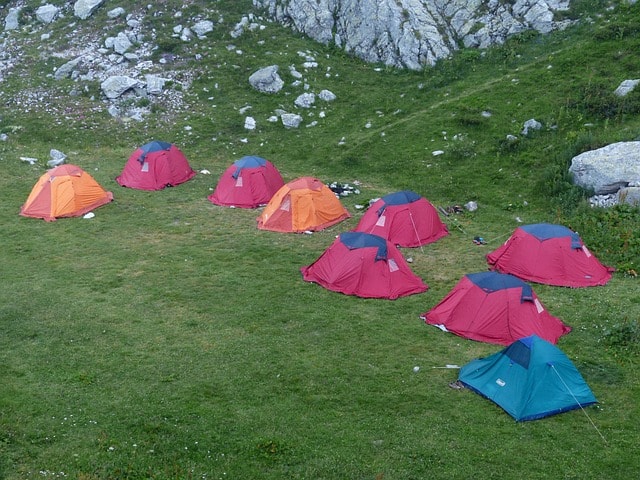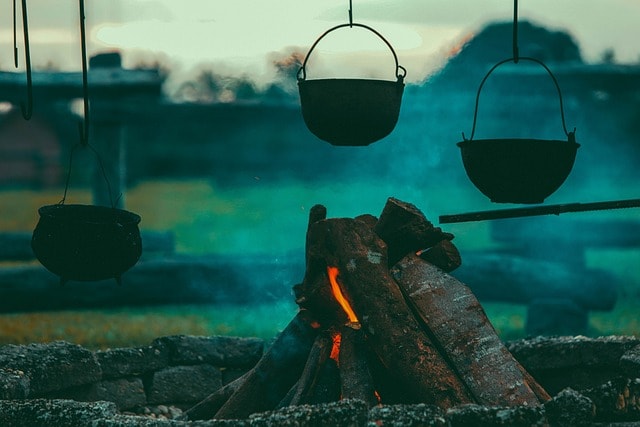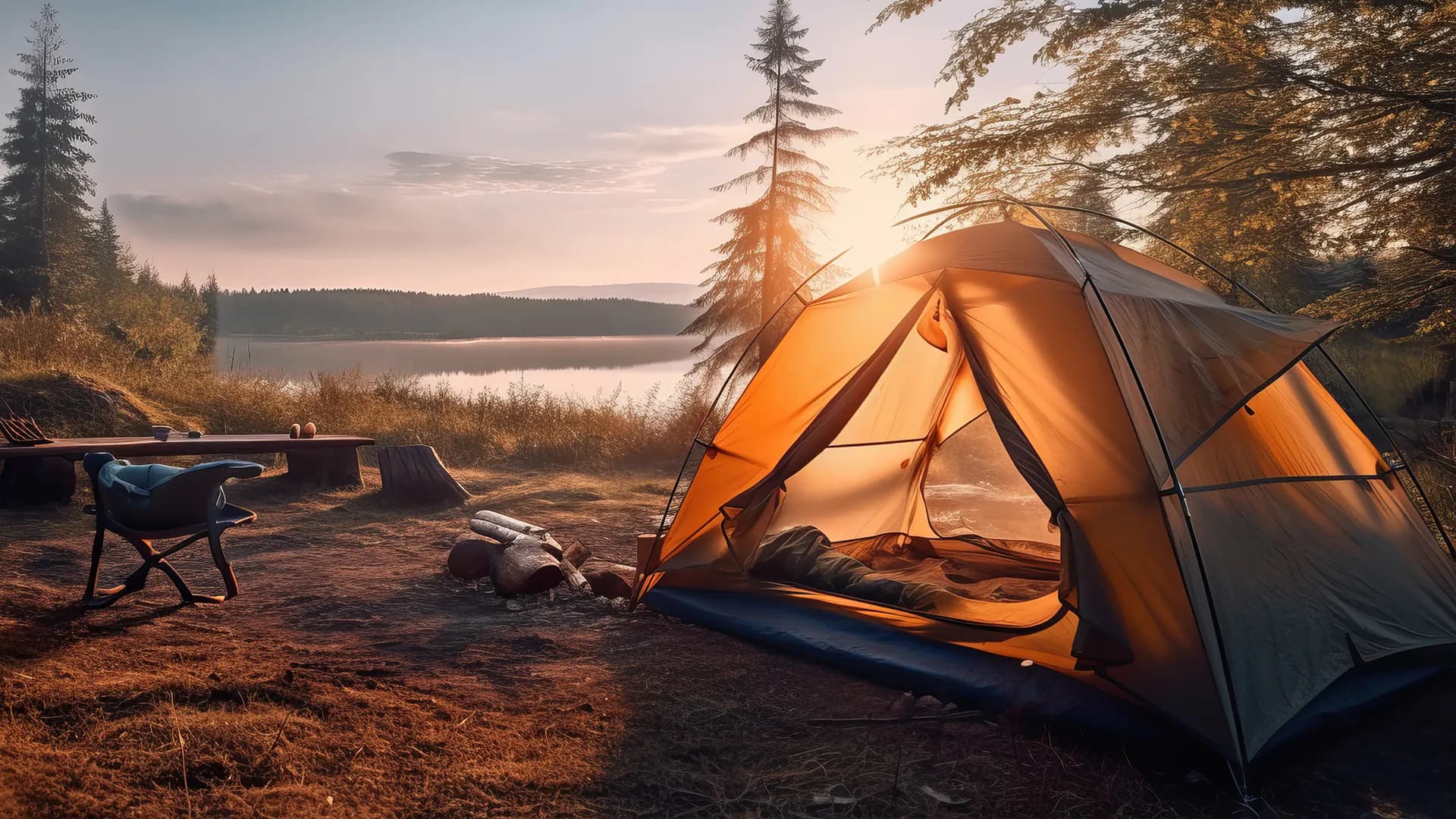Introduction
Picking the right campground or campsite can make your camping trip awesome. Having the right camping information is crucial to plan a successful trip. This guide gives tips on choosing the perfect campsite to ensure safety, comfort, and fun.
What is a campground?
The term camp comes from the Latin word campus, meaning "field". Therefore, a campground consists typically of open pieces of ground where a camper can pitch a tent or park a camper. More specifically a campsite is a dedicated area set aside for camping and for which often a user fee is charged. Campsites typically feature a few (but sometimes no) improvements.
Dedicated campsites, known as campgrounds, usually have some amenities. Common amenities include, listed roughly in order from most to least common:
- Fireplaces or fire pits in which to build campfires (this can be a circle of rocks, a metal enclosure, a metal grate, a concrete spot, or even just a hole).
- Road access for vehicles
- A gravel or concrete pad on which to park a vehicle
- Picnic tables
- Marked spaces indicating a boundary for one camper or a group of campers
- Reservations to ensure there will be available space to camp
- Utility hookups, such as electricity, water, and sewer, primarily for the use of travel trailers, recreational vehicles, or similar
- Raised platforms on which to set up tents
- Piped potable water
Campgrounds may include further amenities:
- Pit toilets (outhouses)
- Flush toilets and showers
- Sinks and mirrors in the bathrooms
- A small convenience store
- Shower facilities (with or without hot water)
- Wood for free or for sale for use in cooking or for a campfire
- Garbage cans or large rubbish bins in which to place refuse
Camping outside a designated campsite may be forbidden by law. It is thought to be a nuisance, harmful to the environment, and is often associated with vagrancy. However, some countries have specific laws and/or regulations allowing camping on public lands (see Freedom to Roam). In the United States, many national and state parks have dedicated campsites and sometimes also allow impromptu backcountry camping by visitors. U.S. National Forests often have established campsites, but generally allow camping anywhere, except within a certain distance of water sources or developed areas. Camping may also be prohibited in certain ‘special areas’ of national forests containing unusual landforms or vegetation. And if conditions allow campfires, a campfire permit is required for campfires outside of developed campsites.
In Britain, it is more commonly known as wild camping and is mostly illegal. However, Scotland has a relaxed view and wild camping is legal in most of Scotland.
In many parts of Canada, "roughing it" or "dormir a la belle etoile" (French) is considered to be wilderness camping on government-owned, public land known as crown land and commonly called "the bush". There are no amenities of any kind and typically no development except for possibly logging roads or ATV trails, and few rules beyond the requirement in some provinces to move the site at least 100 meters every 21 days.
Consider Your Needs for Your Next Camping Trip
- Location: Decide if you want a remote wilderness experience or a developed campground with amenities.
- Group Size: Make sure the campsite can fit your group and the number of tents you have.
- Accessibility: Consider how far the site is from parking areas, especially if you have heavy gear or mobility issues. Look for accessible campsites that are specifically designed for individuals with disabilities, ensuring proper identification and adherence to policies that keep these sites available for those who need them.
- Camping Reservations: Making camping reservations is crucial for securing a spot at campgrounds and campsites. Proper planning and utilizing the right resources for reservations can significantly enhance your overall camping experience.

Evaluate the Environment with National Park Service Guidelines
- Terrain: Look for flat, level ground for setting up tents. Many campsites offer such terrain along with other amenities, making them suitable for different camping experiences. Avoid low areas that might flood.
- Shade and Sun: Pick a spot with a balance of sun and shade to stay comfortable.
- Water Source: Being close to water is convenient, but make sure it’s safe and not likely to flood.
- Developed Campsites: Consider developed campsites for family camping. These sites come equipped with amenities such as fire pits, picnic tables, and a water supply. They often have regulations regarding reservations and provisions for youth campers, providing a more comfortable and organized camping experience.
Safety Considerations
- Weather Protection: Find natural barriers like trees or rocks that can protect you from wind and rain.
- Wildlife: Be aware of local wildlife and choose a site that minimizes risk. In national forests, specific wildlife considerations include understanding the presence of bears, mountain lions, and other potentially dangerous animals. Store food securely to avoid attracting animals.
- Hazards: Avoid areas near dead trees, cliffs, or other natural hazards.
- Safety Regulations: When camping on public land, it is crucial to understand and follow safety regulations. U.S. National Forests often provide established campsites and allow camping in undeveloped areas with certain restrictions, such as proximity to water sources or developed locations.

Amenities, Facilities, and Accessible Campsites
- Restrooms: If you prefer facilities, choose a campsite with restrooms or outhouses.
- Fire Pits: Make sure the site has designated fire pits for cooking and warmth.
- Picnic Tables and Benches: These add convenience and comfort to your camping experience. Other amenities, such as showers, laundry facilities, and Wi-Fi, can further enhance your stay.
- Facilities at Many Campgrounds: Many campgrounds offer a variety of facilities for RV camping, including hookups, dump stations, and recreational areas. Both commercial and governmental campgrounds provide diverse and accessible options, sometimes charging fees or operating on donations.
Regulations, Permits, and Camping Reservations
- Check Rules: Understand the rules and regulations of the campsite, including fire restrictions and quiet hours. The National Park Service plays a crucial role in managing these regulations to ensure the protection of the environment and resources within national parks.
- Permits: Get any necessary permits for camping, especially in popular or protected areas.
- Federal Lands Regulations: When camping on federal lands, it's important to understand the historical context and current regulations. President Theodore Roosevelt's 1901 call for the creation of free campgrounds on these lands led to the establishment of national parks and regulated camping options provided by the federal government.

Conclusion
Choosing the perfect campsite involves considering your needs, evaluating the environment, ensuring safety, and understanding regulations. By following these tips, you can pick a campsite that enhances your camping experience and provides comfort and enjoyment.
Camping is a wonderful way to create memories with loved ones, whether through exploring nature, bonding over shared activities, or simply enjoying each other's company. Please don't forget to plan your next camping trip carefully to make sure you have a memorable and stress-free adventure. Happy camping!
